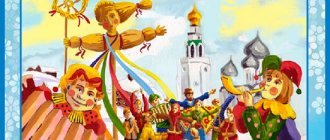Feed all your neighbors at once
Participation is accepted by guests who have neighbors both to the right and to the left, for example, the second at the table, the fourth, and so on. In front of the participants there are plates with the same contents, for example, mashed potatoes or sour cream, and each participant has two spoons in their hands: one in the left hand, the other in the right. At the “start” command, participants begin to feed their neighbors, simultaneously working with both their right and left hands. Whichever participant feeds the contents of his plate to his neighbors faster will win. A prize will also be given to the most patient and diligent “neighbor” who may have to eat from the hands of two participants at once.
Traveling by country
The presenter prepares “compromising evidence” on the countries for this competition - any two pictures characterizing a specific country. The presenter takes turns showing two pictures, and the guests at the table guess the country itself. Whoever has the most guessed countries is the winner. Examples of pictures: 1. Bear and balalaika (Russia); 2. Carnival and coffee (Brazil); 3. Sombreros and maracas (Mexico); 4. Pizza and gladiator fights (Italy); 5. Tulips and cheese (Holland); 6. Banks (institutions) and watches (Switzerland) and so on.
Ancient folk games card index
OLD RUSSIAN GAMES
Here is a selection of traditional fun games of the 19th century that amused our ancestors on boring evenings. These entertainments do not require any special equipment or preparation. And you can play in a small group, in a family, or in a large company of children and adults.
GAME "TERGACHI"
A “vodir” is chosen (now we call it “driving”, and children even now often speak in the old fashioned way with the emphasis on the first syllable - “voda”). The water guy is blindfolded. The remaining participants in the game are players. In this game they are called "twitchers". Rule of the game: players are prohibited from leaving their place. If this rule is violated, the player becomes a “water man”.
How to play: Vodir stands in the center of the room, blindfolded. Players enter the room and sit near the walls. Vodir begins to walk around the room. The players attract the waterman’s attention and “tug” him. For example, they say “Turg-twitch” or rustle their feet on the floor or rustle their clothes in turns. Someone pulled the waterman by the hem. And then on the other side they whispered: “Derg-derg,” and after that a new sound - someone slapping their knees. The waterman needs to guess who pulled him (that is, said or slammed or made some kind of sound). If he guessed right, he transfers his role to the puller. Then the twitcher, who has been solved, becomes the waterman in the new game. The players' task is to confuse the waterman so that he cannot guess who it is. Therefore, they may speak in a voice that is not their own - squeaky or, on the contrary, bass, etc.
GAME "COTTON"
A very simple game. Everyone stands in a circle and throws a piece of cotton wool up (you need to fluff it up; throwing a roll of cotton wool is useless - it won’t fly :). The goal is to prevent the cotton wool from falling. The player near whom the clapper falls pays a forfeit (sings a song, crows, reads a poem, etc.). Therefore, everyone is trying to quickly blow the cotton away from themselves to their neighbor. The cotton flies either higher or lower, so the players either squat, then stand on tiptoe, or bend over. Usually the result is a very funny picture.
If there are few players, then the game is played at the table. They toss the cotton and keep their hands under the table. Next to whom the cotton “landed”, he pays a fine - a forfeit.
GAME "WING"
The driver is selected. The players sit at the table, and under the table in a circle they pass each other an object tied to a thread. At the same time they say:
Oh, little wing, hurry up,
Don't falter and don't lose your temper,
Don't look from under the table
Otherwise there will be trouble.
The object must be passed on a string in such a way that the driver does not guess who has the “wing.” Therefore, the players, even without a wing, pretend that they are passing it on, wink at each other and try in every possible way to confuse the driver. On the last word in the text (this is the word “trouble”), the “wing” stops on one of the players. The driver's task is to guess who has the wing and where it stopped. If he guessed right, then this player with the wing in his hands becomes the driver in the next game. If not, then the driver pays a forfeit. Redemption of a phanta - a song, dance, riddle, congratulation or trick. It is important not to break the thread when passing an item on a string. Whoever breaks the thread also pays a forfeit.
GAME “BIRDS FLY”
All players sit in a circle at the table. One hand is on the table. The presenter begins the story: “I traveled a lot to different countries. And I came to this wonderful conclusion: all living creatures covered with feathers fly. All birds fly." At the last words, the presenter raises his index finger up and everyone repeats after him. The rule of the game is reported: if it is a bird and it flies, then you need to raise your index finger up. Then the presenter continues: “And ducks fly (the driver and players raise a finger up for each correct phrase), and geese fly, and tits fly. And lions fly” Many players will automatically raise their fingers up. And they will be wrong. The game must be played at a fast pace, alternating birds, animals, fish, insects (they also fly, but they are not birds, and therefore there is no need to raise a finger), flying objects - autumn leaves, an arrow (there is no need to raise a finger, because this is not bird). Everyone who made a mistake pays forfeits at the end of the game and completes simple tasks.
PULL AND PUT GAME
A very simple and fun attention game in which even adults often make mistakes. You will need wide satin ribbons about a meter long. How many players are in the game - so many ribbons you need. The host of the game stands in the center of the room, and the players sit on chairs around him. The chairs are placed in a circle. The driver in the center of the circle holds all the ribbons. He gives the other end of the tape to each player. Ribbons like rays of the sun go from him to the players. The presenter quickly says either “Pull” or “Let”. What is the highlight of this fun game? The problem is that when you say “pull,” you have to release the tape. But for the word “let” you need to pull the tape, on the contrary! There will be a lot of mistakes! In this game you can collect forfeits for mistakes. Or you can do the opposite - play for the winner, who will receive a small prize for not making a mistake.
GAME "PLATE"
Players stand or sit in a circle. Each player names himself after an animal. For example, “I am a hare.” “And I’m a fox,” etc. When everyone has remembered each other's new names, the game begins. Take a wooden (antique version) or plastic plate, bowl (modern version) and twist it tightly so that it spins (Instead of a plate, you can use many other modern objects, for example, a roll of stationery tape. The main thing is that the object can be twisted). When the plate spins, immediately shout out the name of one of the players. For example: “Hare, catch it!” The hare needs to catch the spinning plate before it falls. Now the hare spins the plate and calls the other player: “Bear, catch it!” etc. In this game, reaction speed is developed; all players need to be very agile, attentive and tenacious. Anyone who did not have time to grab the plate pays a forfeit.
Games that reflect the daily activities of our ancestors
Seine
This gambling game can be played in the summer in any body of water that has shallows. For greatest safety, you need to choose places where there is no strong current. It is better if many people participate in the game, preferably there should be no less than 6-8. All players are divided into two teams - one team will represent the “fishermen”, and the second - the “fish”. Fish can move throughout the entire territory designated for the game. You should not go into the deepest parts of the river. The goal of the fishermen is to catch as many fish as possible. To do this, fishermen join their hands and try to surround the “prey” with a chain resembling a net. Fish can escape in any way - swimming, diving, moving through shallow water. When the fishermen close the circle and narrow it so that the fish have nowhere to go, the teams change places and the game starts over.
According to some rules, fish can only run away until the fishermen close the circle. After this, the fish that did not have time to escape from the circle are considered caught, since it is not allowed to escape by slipping under the hands of the fishermen.
Fishing rod
This game can be played both on the court and on the water. An inflatable ball is wound onto a skipping rope and spun in a circle, the driver says:
I'll put out a fishing rod and catch a lot of fish. I’ll make some delicious fish soup and invite all my best friends.
If they are playing on the playground, then the children must jump over the “fishing rod”. If the game takes place on the water, then the children must have time to dive so that the ball does not touch them.
The last one standing wins.
Bird catcher
You can play on any site. The number of players is not limited.
At the beginning of the game, a driver is selected and blindfolded. Children come up with some kind of bird whose voice they can imitate and disperse around the playground.
In the forest, in the woods, on a green oak tree. The birds are singing merrily, Ay! The bird catcher is coming! He will take us into captivity, Birds, fly away!
After these words, the driver claps his hands, the children freeze, and he tries to find them. As soon as he finds the player, he asks him to identify himself. The found “bird” must pronounce those sounds that are characteristic of it in nature. The driver’s task is to guess what kind of bird is in front of him and who the child is who is portraying it.
Note: “birds” are not allowed to hide behind objects that will block the path of the “catcher”.
Brook
This game is very old, our grandparents loved to play it. She is cheerful and perky.
A driver is chosen from all the participants, and the rest of the girls and boys, holding hands, become pairs, after which they line up in a column and raise their clasped hands up above their heads. The driver must run along the resulting “corridor” to take someone as his partner and take her to the end of the column. The one whose pair is broken goes to the beginning of the stream and runs the same way as the first driver. Gradually the trickle moves.
The more participants, the more interesting this game becomes.
Previously, in Rus', this game was used to get to know a girl or boy you liked, or simply as fun at folk festivals.
Baba Yaga
Baba Yaga is the most common and famous fairy-tale heroine, who must not only be harmful and evil, but also be able to keep herself in good shape.
This game is very fun and funny. You can play it with the whole family during the holidays or organize a relay test at school.
Relay rules: children must line up in columns one after another. The relay race will be carried out with a bucket on your leg and a broom in your hand. After running a given distance, the players return to the team and pass the baton to the next participant. The team whose members complete this task the fastest wins.
Zarya-zarnitsa
The number of players is not limited. Additionally, you will need a ribbon to play. From all the players, a driver is chosen, the rest of the children stand in a circle and say:
Dawn-lightning, Red maiden, Walked across the field, Dropped the keys, Golden keys, Blue ribbons, Entwined rings - She went for water!
The players standing in a circle hold their hands behind their backs, and the driver walks around the circle and chooses someone to put a ribbon on their shoulder. After the driver has chosen a player for the pair, he puts a ribbon on his shoulder, and they both run sharply in different directions in a circle, the one who does not get an empty seat remains to drive.
Grandfather-horn
Before the start of the game, a driver is selected from among the participants, who is considered a “sorcerer”, “grandfather-horn”. At the initial stages of the game, the grandfather-horn sits in a specially designated “house” (a space outlined on the site), and does not show himself in any way. At this time, the remaining players, having divided into two equal groups, move away in opposite directions from the “house” at a distance of about twenty steps and draw or mark a line with a branch - this is where the house of this part of the players is located. Between the houses of both teams and the grandfather-horn there is a “field”.
The game begins with Grandfather Horn saying:
-Who is afraid of me?
Players from both teams run from house to house across the field, teasing the driver and answering him: “No one is afraid!”
The goal of the grandfather horn is to catch one of the players by unexpectedly jumping out of the house. A player who is caught by a sorcerer, sits in his house and is considered bewitched, cannot escape. He can leave the sorcerer's house only with the help of his comrades. While in the house of the horn grandfather, the player can stretch his arms over the line and shout: “Tea, tea, help out!” If one of the players manages to run up to the house of the horn grandfather and touch the enchanted captive with his hand, then he “comes to life” and can run away.
The game ends when Grandpa Horn catches all the players. The one who was caught first in the previous one leads the next race.
Hunters and ducks
The game requires a fairly large open area, in the center of which a mark is made - a large circle is outlined. A ball is used as equipment. As many people as possible should participate in the game, the minimum number is about 8-10. All players are divided into two teams, one of which becomes the “hunters”, and the second - the “ducks”. During the game, the ducks must remain inside the circle, and the hunters must remain outside it. The task of the hunting team is to throw the ball at the “flock of ducks”, trying to hit one of them. The ducks, accordingly, move inside the circle, trying to escape from the “hunter’s bullets.” A duck that is hit by the ball is considered “killed” and leaves the game. Hunters must not step inside the circle, and by doing so they are breaking the rules. The throw of a hunter who steps over the line is not counted. Ducks, on the contrary, should not run out of the circle. For such a violation, the duck leaves the game. A hit with the ball must be direct, without bouncing off the ground or another player, only in this case is it counted. Another rule stipulates that hunters should not aim at the heads of players on the opposing team. If the ball hits the duck's head, the hit does not count.
When all the ducks inside the circle are “killed,” the teams switch places. The winner is the team that knocked out all the ducks faster than the other, or knocked out the most ducks within a predetermined time.
Folklore festivals and competitions
Few people know the fact that folklore fashion is not a modern trend. And folklore festivals are not an innovation, but a return to the roots. Interest in traditional musical cultures, folklore, has continued since the beginning of the history of European music. Folk song and folk culture were in many ways the ancestors of European music. The role of folklore, its influence and meaning have changed and been different in every corner of the continent, but have always remained. After all, folk music is the music of all people, without distinction of class origin, financial status or gender.
Folk dances and songs found their way in unchanged or improved form not only into the halls of magnificent palaces and estates, but also inspired religious creativity. Folklore was used by opera composers who were looking for rich and varied means of shaping their fantasies. At each fair, musicians not only played local music, but also portrayed a certain stage image typical of it.
Folk music was the sound reflection of folk legends, fairy tales or myths. She talked about love, ignorance, fear. The simplicity with which folk music expressed joy and sincerity, with which the music spoke about suffering, did not allow it to be forgotten even in the times of the great classical geniuses. This, as well as the desire of people to know their roots better, became the reasons for the great revival of folk song in the 20th century. Nowadays folk music has become part of the regular program of most festivals, and many folk festivals have appeared.
And as soon as the time for festivals approaches, a lot of fans go on a trip throughout Europe. There is something special, magical about folklore festivals that is not found in any other form of public entertainment. Many people go to these same places year after year. Every time at such folklore festivals one gets acquainted with fantastic singers, artists, choirs, the public about whom one can usually only read about in the media and see on the silver screen. Festivals are not only an artistic program with leisure, but also a whole preparatory process, where the first place is the travel, which often evokes no less emotions than the performance itself. Many have made their own tradition out of the trip to the folklore festival - they travel by bus, train, or plane while having a wonderful time. Very often, groups take their friends and relatives with them to the folklore festival. Equally popular have become international exchanges organized to gain intercultural experience, improve the level of performance and develop tolerance towards other societies. Folk music has now begun not only to represent the culture of a given country, but also to address, as is noticeable at folk festivals, ethnicity and ethnic values.
Malechina-Kalechina
An ancient entertainment that is still relevant today. The essence of the game is that the stick is placed in a vertical position on the tip of one or two fingers. In this case, it is forbidden to support the “tool” with your hands.
When addressing the male, you must say the following rhyme:
“Malechina-kalechina, how many hours until evening? One two Three …"
The counting continues until the stick falls. If it sways, you are allowed to pick up the stick with your other hand so as not to drop it. The winner is the one who counts to the highest number.









